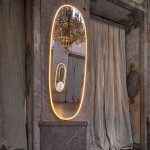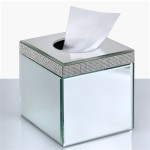How High to Hang a Mirror Over a Mantle: A Comprehensive Guide
Hanging a mirror above a fireplace mantle is a common and effective way to enhance the aesthetic appeal of a room. A well-placed mirror can create the illusion of increased space, reflect light to brighten the area, and serve as a striking focal point. However, achieving the desired effect hinges on selecting the appropriate height for placement. Deviating from established guidelines can result in a visually awkward arrangement that detracts from, rather than enhances, the room's ambiance. This article provides a detailed guide on determining the optimal height for hanging a mirror above a mantle, taking into consideration various factors that influence the decision-making process.
The height at which a mirror should be hung over a mantle is not a static measurement but rather a context-dependent decision. Several factors play a role in determining the ideal placement, including the size and style of the mirror, the dimensions of the mantle itself, the height of the ceiling, and the overall design scheme of the room. A failure to consider these elements can lead to a disproportionate or unbalanced arrangement that undermines the visual harmony of the space. A systematic approach, incorporating careful measurements and a keen eye for proportion, is essential for achieving a successful outcome.
Considering the Mantle and Mirror Dimensions
The relative sizes of the mantle and the mirror are paramount considerations when determining the optimal hanging height. The mirror should generally be narrower than the mantle itself, leaving a visible margin of space on either side. The width of this margin is a matter of preference, but a general guideline is to aim for a margin that is roughly proportional to the overall dimensions of the mantle. A disproportionately wide mirror can overwhelm the mantle, while a mirror that is too narrow may appear insignificant and out of place.
The height of the mantle also plays a critical role. A taller mantle can accommodate a larger mirror positioned higher above its surface, while a shorter mantle may necessitate a smaller mirror placed closer to the top edge. The goal is to create a balanced visual relationship between the two elements. A mirror that is too tall for the mantle can appear top-heavy, while a mirror that is too short may look lost and underemphasized. Careful measurement and visual assessment are essential to avoid these pitfalls.
In addition to the overall dimensions, the style and design of both the mantle and the mirror should be taken into account. A highly ornate mantle may call for a simpler, more understated mirror, while a minimalist mantle can be complemented by a more elaborate and decorative mirror. The height at which the mirror is hung can further enhance this interplay of styles. For instance, a simple, modern mirror might be hung slightly higher above a traditional mantle to create a sense of contrast, while a more ornate mirror might be hung closer to the mantle to emphasize its traditional character.
A common rule of thumb suggests that the bottom of the mirror should be positioned approximately 4-6 inches above the top of the mantle. This guideline provides a starting point but should be adjusted based on the specific characteristics of the mantle and mirror. For instance, if the mantle is particularly tall, a slightly greater distance may be appropriate. Conversely, if the mirror is quite small, a smaller gap may be preferred to maintain a sense of visual connection.
Accounting for Ceiling Height and Room Proportion
The height of the ceiling has a significant impact on the perceived scale and proportion of the room. In rooms with high ceilings, a mirror can be hung higher above the mantle to visually extend the vertical space. This can help to prevent the room from feeling too cavernous and create a more balanced overall appearance. Conversely, in rooms with low ceilings, hanging the mirror too high can exacerbate the lack of vertical space, making the room feel cramped and confined.
When considering ceiling height, it is important to maintain a sense of proportion between the mirror, the mantle, and the rest of the room. The mirror should not appear to be floating too high above the mantle, nor should it feel dwarfed by the surrounding space. This requires careful consideration of the mirror's size and shape, as well as the overall dimensions of the room. Larger mirrors are generally better suited for rooms with high ceilings, while smaller mirrors are more appropriate for rooms with low ceilings.
The height of other furniture in the room should also be taken into account. The mirror should be hung at a height that is visually harmonious with the adjacent furnishings. For example, if there is a tall bookcase or cabinet near the fireplace, the mirror might be hung slightly higher to complement the vertical scale of the other furniture. Conversely, if the furniture is primarily low-profile, the mirror might be hung lower to maintain a sense of balance. The objective is to create a cohesive and visually appealing arrangement that integrates the mirror into the overall design scheme of the room.
Furthermore, the function of the mirror should be considered in relation to the ceiling height. If the mirror is intended primarily for reflecting light and creating a sense of spaciousness, it may be beneficial to hang it higher to maximize its reflective capabilities. However, if the mirror is primarily intended for decorative purposes, the height may be less critical, and the focus can be placed on achieving a visually pleasing arrangement with the mantle and other surrounding elements.
Considering Viewing Angles and Visual Balance
The primary viewing angles of the mirror should be considered when determining the optimal hanging height. The mirror should be positioned in such a way that it reflects the most desirable views within the room. This may involve adjusting the height to capture reflections of natural light sources, attractive architectural features, or visually interesting elements of the decor. A mirror that reflects an unattractive or cluttered area of the room will detract from, rather than enhance, the overall aesthetic appeal.
The height should also take into account the typical viewing position of individuals within the room. If the mirror is primarily viewed from a seated position, it should be hung at a height that is comfortable and visually accessible. This may involve positioning the mirror slightly lower to ensure that it is easily visible from the sofas, chairs, or other seating areas. Conversely, if the mirror is primarily viewed from a standing position, a slightly higher placement may be more appropriate.
Visual balance is a crucial element in achieving a harmonious arrangement. The mirror should be hung at a height that creates a sense of equilibrium with the mantle and the surrounding elements. This involves considering the weight and visual presence of the mirror, as well as the overall balance of the room. A mirror that is hung too high or too low can disrupt the visual balance and create a sense of imbalance. Experimentation and visual assessment are often necessary to achieve the desired effect.
To further enhance visual balance, consider adding decorative elements around the mirror. Sconces, artwork, or other decorative items can be strategically placed to complement the mirror and create a more visually interesting arrangement. These elements can also help to balance the visual weight of the mirror and prevent it from feeling isolated or out of place. The key is to create a cohesive and visually appealing composition that integrates the mirror seamlessly into the overall design scheme of the room.
Ultimately, the optimal height for hanging a mirror over a mantle is a matter of personal preference and visual judgment. While the guidelines outlined in this article provide a valuable starting point, the final decision should be based on a careful assessment of the specific characteristics of the mantle, mirror, ceiling height, and overall design scheme of the room. Experimentation and visual assessment are essential for achieving a balanced and harmonious arrangement that enhances the aesthetic appeal of the space.

Things To Know Before Hanging A Mirror Above The Fireplace
:max_bytes(150000):strip_icc()/271342800_619280975946855_5866172257895318662_n-f6b2756c1768481b9b258f56fe44d13a.jpg?strip=all)
Design Guide To Putting A Mirror Over The Fireplace

Mirror Over The Mantel What Size To Get Laurel Home

Mirror Over Fireplace Design Tips And Ideas

Round Mirror Over Fireplace Tradux Mirrors

How To Hang Mirrors Angela Bunt Creative

Mirror Over The Mantel What Size To Get Laurel Home

Round Mirror Over Fireplace Tradux Mirrors

Feng Shui Rules For A Mirror Over The Fireplace Lovetoknow

Mirror Over The Mantel What Size To Get Laurel Home








